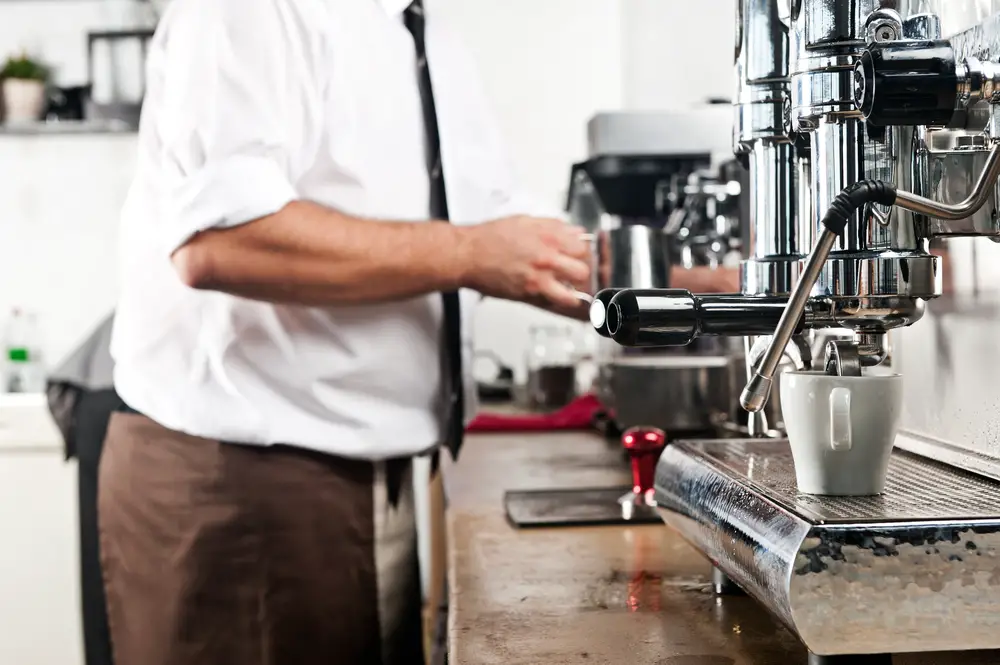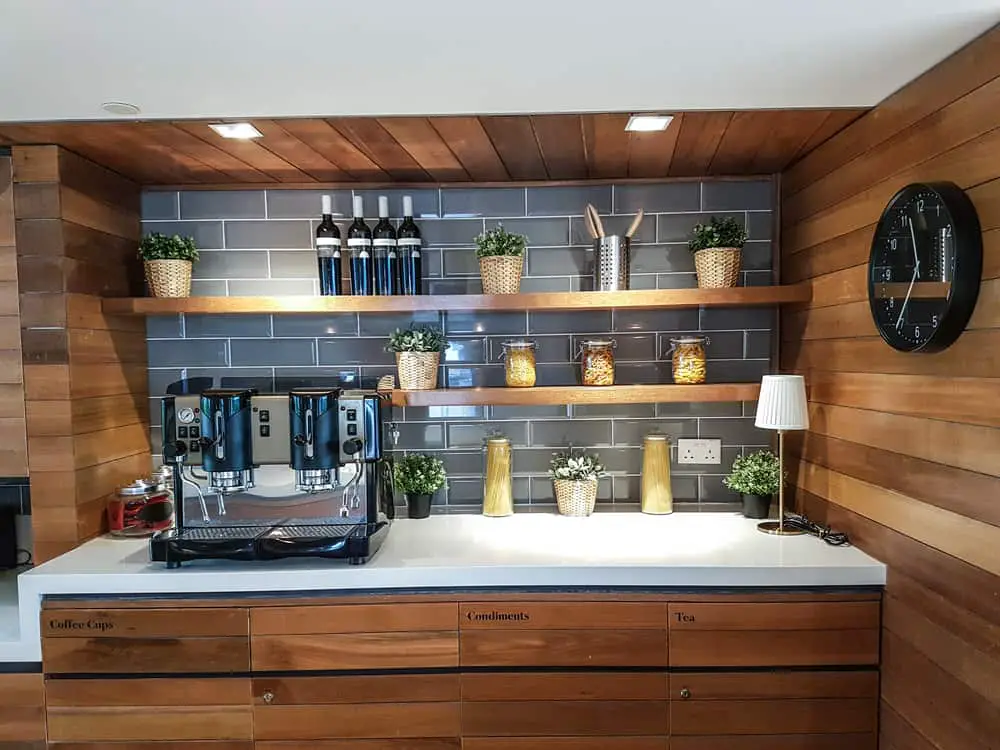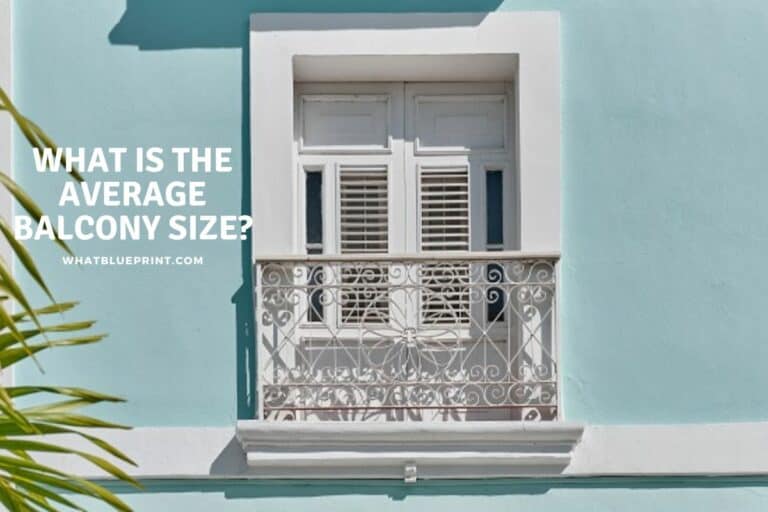How Tall Should A Coffee Station Be?
The weirdest things can pop into your brain at funerals as you struggle to come to terms with the loss of someone dear to you and cast about for something less painful to occupy your mind. Often, the thoughts are mundane, nonsensical, or just plain random, as I found at a funeral a few months ago: I watched one of the catering staff – an elderly lady – struggle to comfortably reach the cups on an espresso machine and suddenly wondered,
How tall should a coffee station be? 36-42 inches is the norm, with 36″ being most common for people of the average height in the USA. 33-34″ is suggested for those in wheelchairs, and the very tall or back sufferers might prefer to have the station at the higher end of the range, avoiding bending.
Until I researched this, I had no idea if there was a set height, if the station was bespoke, or if anyone had ever bothered to consider the height – or lack thereof – of the various people who would be using it. I mean, an office coffee station can obviously not be tailored to the various people who would be using it, could it?
A coffee station for the home is surely a different kettle of fish (never understood that expression; who keeps fish in a kettle?) and could certainly be made to a specific height for the homeowner. That got me thinking further: If the whole family drank coffee, would the coffee station be made to their average height or aimed at a designated coffee-preparer?
Several weeks after the funeral, these questions came swimming back, and since I had loads of questions and not a single answer, I went to work looking for solutions.
The Standard Counter Height At Home
Bathrooms are a little different, but unless you are a total coffee nut, we’ll stick to kitchens and bars, where the standard counter height in the continental USA is 36″, rising to 42″ if you plan to sit around the counter. The higher measurement is often used in kitchen islands, as they generally incorporate bar-style seating for family meals.
This is not a randomly chosen height, and maximizes countertop-task ergonomics for adults of an average height, in this case, 5’10” / 1.78m.
If you plan to incorporate cabinets into the design of your coffee station – an excellent idea, though by no means obligatory – sticking to standard measurements might make your life a lot easier, providing these measurements do not force you to stretch up or bend down, too far.
Base cabinets for the kitchen are usually 34.5″ in height, and standard countertops are 1.5″ in height, taking us to the 36″ already mentioned.
Bespoke Coffee Stations
These will ignore the norms for several reasons:
- The height of the principal coffee station user may be such that using the station becomes uncomfortable, or even painful over time, for them. Bending or stretching to use the station would be easy at first, but constant repetition may cause back or shoulder injury.
- To fit in with an already non-standard kitchen
- As a statement, a coffee station is, on occasion, created at a different height, becoming the focal point of a room or area.
Naturally, the avoidance of standard measurements should not result in too great a difference in height, as the machine still needs to be manually operated and the station cleaned and replenished.
Interestingly, one couple in Finland I read about constructed a coffee station above a tropical fish tank, raising the counter to accommodate the tank below. Access to the station required a step, which they constructed from wood – a small price to pay for a stunning result.
Sometimes, however, a coffee station might be raised by four to six inches simply to make a statement. This is easily done if no cabinets are to be constructed below the station, but a drawer or similar might require construction if cabinets are being used. This is, of course, to prevent a gap between cabinet and station, which would be a real eyesore.
Consider any Accessible Service Laws which may be pertinent to your state or country. Building codes are sometimes demanding, and you don’t want your perfect coffee station to be refused by the authorities. Worse still, it would be to have it ripped out if you went ahead without planning approval if such is required.
Considerations For The Physically Impaired
Those in wheelchairs or similar devices may not comfortably manage a height of 36″ for the counter of the coffee station, and a height of 33-34″ is probably more suitable. People with walking frames might prefer a counter height and thus a station at the standard 36″.
This will allow the walking frame to fit under the coffee station for ease of access. Frames are generally 24-35″. The cabinet below the coffee station would be removed in the above scenario.
One caveat to consider is the impact of any non-standard work you do on the future sale of the house (if indeed your coffee station is for the home). The non-standard measurements might be unavoidable in the case of a physical need, but if it’s purely for aesthetic reasons, consider that the next owner might not have your great taste in décor.

How Wide Should A Coffee Station Be?
This answer is much easier to calculate than the height I found. Most important is the coffee machine itself, after which the preparation area on the side is paramount. If you are simply going for a drip/filter coffee machine, you will need space for the heating element and the jug, cups, saucers, sugar-bowl, cream jug, spoon stand, etc., at the least.
If you go big and set up a decent espresso machine, you will need everything above plus a knock-box, tamper, rubber mat, milk jugs of several sizes, and if you are going to do this properly, a burr grinder.
Setting up a general-purpose coffee station may seem the best idea of all, but it’s impractical when you consider the weight of the espresso machine (presuming you buy one that is not a plastic-housed unit. In this case, it’s not the weight that is prohibitive to move, but the fragility of the machine). Decide on what coffee methods you will be employing for the most part and go from there.
If, for example, you generally enjoy an espresso-based drink (cappuccino, latte, macchiato, etc.) but want the option of a French-Press or Pour-over on occasion, you can always move the rubber mat and tamper aside and use the space freed up.
Selecting The Location For A Coffee Station
- Close To Water Supply
If you plan to use a coffee/espresso machine that requires water from the mains, consider this when planning. If using a reservoir in the machine, you might prefer to be close to a tap to avoid dripping water on the floor as you walk. Location is especially important if a specific tap has a water purification system.
- Power Outlets
You will need the power to produce coffee, and while a coffee station on a kitchen island sounds dreamy, it becomes a nightmare if you have to run extension cords from a wall plug which can be very dangerous.
Configuring A Coffee Station:
- Regular, Drip/Filter
If you go with an entry-level machine like the Black & Decker Coffee Maker for U$44 at Amazon, you will have a very small footprint of 6 x 13″. That’s six inches in width, and once you have left space for cups, etc., you can easily get away with 15×15″. This will enable you to prepare your coffee with enough space, of which very little will be wasted.
A bigger unit like the Breville Precision Brewer (U$300 from Amazon) will take up more space, so before you start construction on the station, take size and access into account. If you decide on a platform or mezzanine above the station, don’t make it so low that you can’t easily see what you are doing when inserting or removing the pot.
Having to do part of the job by touch is annoying at best, and a clear line of sight from your eye to the back of the machine is essential. Filter papers need to be inserted into the top of drip machines, and the water needs to be poured onto the ground coffee, so a lot of clearance will be needed. I’d suggest you add another 50% of the unit’s height. A machine that is 15″ high needs a station offering 23″ of clearance.
The Precision Brewer (12.4 x 6.7 x 15.7″) is twice as wide as the B&D unit but half as deep, so one might think it’s simply a matter of turning the one to take up the same space as the other, but the location of the buttons and dials would put paid to that idea. So we see that it’s not only the size of the coffee machine that must be considered when designing the station but also its configuration.
With the Precision Brewer, it is possible to have cups, jugs, etc., in front of the unit, but this would quickly become tiresome, and I’d urge you plan to make this operation a pleasant one by giving yourself a decent workspace.
- Espresso Machine
Unless you go with an espresso machine plumbed into mains, you will often – but not always – need to lift the reservoir out, above the machine, either from one side or the back. You will need to more than double the height measurement for clearance in this event.
If you go the plumbed-into-mains route, there will be a heating plate on the top of the machine for keeping cups warm. This plate will also heat ( and possibly warp) any platform or shelf above the unit, so leave enough space for the heat to dissipate.
Small units bought at appliance stores are invariably made of plastic and should have enough distance from the sides – if any sides exist – of the station to avoid overheating. These units may be very small, but they will all have a reservoir to refill from the top, and the smaller the unit, the more often you will be refilling.
Prices vary enormously, as do the functions, but since we are focusing on size here, the bare-bones machines will generally offer the same footprint as a drip machine. If you’re buying one of the machines, you will probably not be planning to grind your own beans, so you can avoid purchasing and finding space for a grinder.
A good espresso machine will be 12″ or so wide, with a very similar depth, but the height will vary, and you will have to consider the machine before constructing the station. Measure twice – cut once. You don’t want to have to adjust the station’s size once built if at all possible.
Some machines have a built-in grinder on top of the machine, and you will need access to this regularly to refill the beans. In addition, you may need to remove or refill the reservoir, too. For example, in the case of a good entry-level unit like the Breville Barista Pro, you would need 40″ of clearance above the machine, always presuming you close the station with a platform or shelf.
Leaving the coffee station open on top alleviates many clearance issues, but it will become dustier over time if not used regularly. Alternatively, the top might only stretch from the rear to a point halfway to the front, allowing plenty of access as well as a small platform for jugs, cups, etc.
Once you commit to good coffee, whether it be espresso or not, you will want a grinder to do the job properly, and these are usually about 6 x 6″ in size. The grinder is usually placed to the left of the machine for right-handers, and you will also need to consider space for your knock-box and your rubber tamping mat.
Remember to check which side of your espresso machine has the steam wand because you will have to leave enough space on that side for milk-steaming, which does require some elbow room.
Conclusion
A coffee station is a wonderful addition to a kitchen, games room, passage, etc. To avoid any issues after the construction, I suggest (gently) that you stick to standardized measurements if cabinets are involved. If not, or if other issues make standard sizes impractical, change the height of the coffee station accordingly, and get started!







